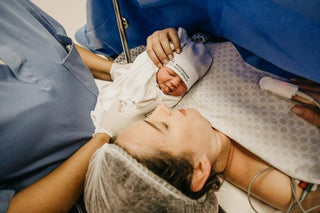Bringing your baby into the world is nothing short of miraculous. As you fall in love with your newborn, you’re also adjusting to a new version of your own body. It’s completely normal to feel that the changes to your vagina after giving birth are surprising, unfamiliar, or even a little overwhelming.
Please hear this: you are not alone. These changes are a natural part of your body’s healing journey. You’ve just done something incredible. With time, gentleness, and proper care, your body will heal, and you’ll feel comfortable again. This guide is here to walk you through the physical changes and share compassionate strategies to support your postpartum recovery.
Understanding What Your Body Went Through
During a vaginal delivery, your body works in amazing ways. Vaginal tissues and pelvic floor muscles stretch to allow your baby to pass through safely. This elasticity makes childbirth possible but also means the area needs time to recover.
After birth, it’s normal for your vagina to feel tender, swollen, and sore. Minor tearing of the perineum (the area between your vagina and anus) is also very common. These changes are expected, and your body begins the healing process immediately.
Common Physical Postpartum Vaginal Symptoms
As your body adjusts after birth, you may notice new sensations. While they can feel unusual, these are usually normal signs of healing. Here are a few common symptoms you can expect:
- Swelling, bruising, and soreness: Tenderness is normal in the first few days. Cold packs can help ease discomfort.
- Vaginal discharge (lochia): Your body is clearing out blood and tissue after birth. Expect heavy flow initially, which gradually lightens over a few weeks.
- Vaginal dryness: Common, especially if breastfeeding. Hormonal changes temporarily reduce natural lubrication.
- A weaker pelvic floor: Muscles that have supported your baby may feel stretched. Slight leaking when coughing or sneezing is common and improves with gentle strengthening exercises.
These changes are all part of normal healing and can be managed with care and patience.
Your Healing Journey: Recovery Timeline for Vaginal Healing
Healing is not a race, and your journey will be unique to you. No matter how you gave birth, the first six weeks postpartum are considered a “recovery” period. Your body has been stretched and stressed to its absolute maximum, and it needs time and grace to recuperate.
While every new mom recovers at a different rate, here is a general timeline of what you can expect:
The First 1-2 Weeks: The Acute Healing Phase
This is when you'll feel the most intense effects of birth. Most acute symptoms, like significant soreness, ease up within the first week or two. You will experience postpartum bleeding, called lochia, which is your body's way of healing. It is typically very heavy, like a heavy period, and bright red for the first 3 to 10 days before it tapers off.
The First 6 Weeks: Your Core Recovery Period
This six-week mark is the milestone most healthcare providers use for the initial recovery phase.
- Perineal Healing: If you had a vaginal birth, your perineum needs time to heal. Recovery can take anywhere from three weeks if you didn’t tear to six weeks or more if you had a perineal tear or an episiotomy.
- Vaginal Changes: You are probably wondering if your vagina after giving birth will ever be the same. While it may not be exactly as it was, it will likely be very close. You can expect the swelling to recede, and within a few weeks, your vagina will have contracted and will begin to regain much of its muscle tone.
- Uterine Healing: Your uterus, which grew to house your baby, should also return to its pre-pregnancy size by the sixth week.
- Postpartum Bleeding (Lochia): Lochia can last up to six weeks. After the first 10 days, it will continue to lighten, changing from red to pink, brown, and yellowish-white.
A Note on C-Section Recovery
If you have delivered your child by C-section, you can expect to spend the first three to four days in the hospital. It generally takes four to six weeks to heal from the surgery and start feeling back to normal.
Remember, factors like a first-time birth or an episiotomy can affect your healing timeline and that’s perfectly normal. Be sure to discuss any concerns you have with your doctor at your postpartum check-up.
Supporting Vaginal Recovery Postpartum
Gentle care can make postpartum recovery more comfortable. Key strategies include:
- Perineal Care: Rinse with a peri bottle after using the toilet, ice the area during the first 24 hours, take warm sitz baths a few times daily, and avoid long periods of sitting or standing.
- Pelvic Floor Exercises (Kegels): Begin once cleared by your doctor to restore muscle tone, bladder control, and core strength. Small, gentle sets throughout the day are sufficient.
- Sexual Health: Resume intimacy when physically and emotionally ready. Use lubricant if needed and communicate openly with your partner.
- C-section Care (if applicable): Clean the incision gently once a day, dry thoroughly, avoid heavy lifting, and postpone intense exercise until advised by your doctor.
- Pain and Aches: Manage soreness with acetaminophen or ibuprofen (safe for breastfeeding), warm showers, heating pads, or gentle massages.
- Digestive Health: Eat fibre-rich foods, stay hydrated, and take short walks to support digestion and prevent straining.
- Breast Care: Use warm compresses or ice packs for sore breasts, wear a comfortable nursing bra, and apply lanolin for cracked nipples. Allow breasts to air out after feeding when possible.
- When to Seek Extra Support: Contact your doctor if you experience fever, foul-smelling discharge, heavy bleeding, worsening pain, or concerns about your incision or perineum. Routine postpartum check-ups help monitor healing and provide emotional guidance.
- Stay Active and Nourished: Gentle walks improve circulation, digestion, and mood, while small, balanced meals with protein, complex carbs, and water aid recovery.
When to Seek Extra Support
Persistent symptoms like pain, incontinence, or discomfort are common but they don’t have to be permanent. Speaking with an obstetrician or a healthcare professional is a proactive step, not a sign of weakness. In some cases, your provider may recommend vaginal rejuvenation treatments or pelvic floor therapy to restore strength, elasticity, and comfort.
During this time, it’s also important to understand what to expect physically and emotionally during your first 6 weeks postpartum. Your body is adjusting, your energy levels may fluctuate, and it can take time for your hormones to regulate postpartum.
Seeking professional guidance ensures that both your physical recovery and emotional well-being are cared for holistically, helping you heal fully and feel more like yourself again.
Flegen’s Support for Your Postpartum Recovery

At Flegen, we understand that your recovery is just as important as your baby’s health. Our lactation specialists in Singapore and postpartum care experts provide:
- Personalised one-on-one guidance tailored to your body’s recovery and healing needs.
- New parents’ workshops designed to nurture, support, and empower you while guiding you through pregnancy and your baby’s early months.
- Infant care courses designed to help you understand your newborn’s sleep, nutrition, and development.
- Practical and gentle exercises to support healing.
From expert advice to hands-on support that makes recovery more manageable at home, Flegen is here to help you feel strong, comfortable, and confident again. Your postpartum journey is unique. Be gentle with yourself, celebrate small wins, and know that with expert guidance and proper care, you will feel like yourself again. Book a consultation today!


